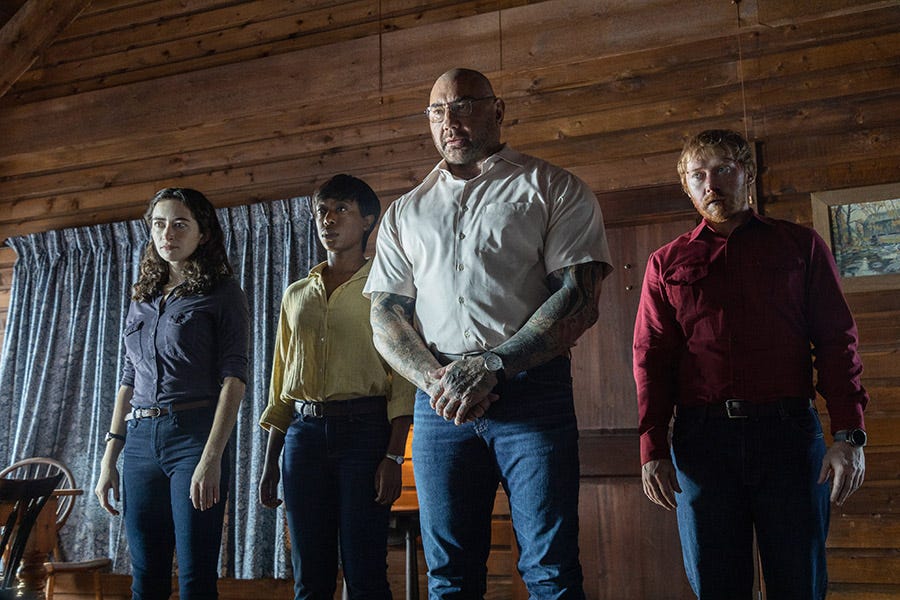"I'm Still Here” Reminds Us We Can’t Go Home Again
This film will profoundly move you in unexpected ways, prompting you to wonder if the concept of home is merely a transitory idea.
Prologue: There's something about old family photos that always stirs me in restless, albeit uncomfortably curious ways. It doesn't matter if they're mine or someone else's. Seeing those frozen moments in time is a powerful reminder that life is short, and those moments will never come again. I’m drawn to know more, and remember and yet… It's a bittersweet mix of nostalgia and the reality of mortality.
Hence, the movie poster for I’m Still Here - an idyllic scene of a happy family in their prime - being a real gut punch. In the photo, the mom looks away wistfully, perhaps all too aware of the threat to come. It’s expertly subtle, revealing much about film’s ability to anchor you in these happy, domestic life moments, only to hint at the insidousness of what lurks beyond.
A Film That Demands You Face Your Old FAMILY Photos Head On
I’m Still Here [Trailer] is directed by Walter Salles, a key figure in the Resumption Cinema in Brazil. This movement, which began after the end of Brazil's military dictatorship in the mid-1980s, ushered in a new era of artistic freedom and exploration in Brazilian filmmaking. Films like the powerful City of God (2002), for example, tell diverse and heart-wrenching stories that highlight poverty and crime, showcasing the country's ability to persevere despite the challenges (and devastation) left by previous regimes.
Salles, known for his earlier work Central Station (1998), which also earned itself a Best International Picture Academy Award nomination, cast Fernanda Torres as the lead in I'm Still Here and we’re all better off for it. She was magnificent and was a close frontrunner for Best Actress for her performance. If she looks familiar, there’s a reason, too. Torres is the daughter of Fernanda Montenegro, who starred in Central Station and has a cameo in her daughter’s film. Spoiler: It’s in the film’s final minutes.
Film Trivia: Montenegro was the first Latin American actress nominated for an Oscar for Best Actress. She was also the first actress to be nominated for a Portuguese-speaking role.
I’m Still Here tells the story of the real-life Paiva family during Brazil's military dictatorship in the early 1970s. It focuses on Eunice Paiva (played by Torres), who must reinvent herself and secure a future for her children after a violent act—her husband's detention—ultimately changes her and her children’s destiny.
I'm Still Here has garnered significant critical acclaim and commercial success. It's nomination for Best Picture at the Academy Awards was a first for a Brazilian-produced film and while it ultimately didn’t win that award, it picked up a win for Best International Film. The movie has also sparked important conversations about Brazil's past, potentially influencing legal decisions regarding amnesty for crimes committed during the dictatorship, which is still very much on the mind of the Brazilians, not unlike the real-life Paiva family, who were impacted by the regime.

Homes Are More Than Just The Place We Rest Our Heads
The beginning of this film is focused on the everyday lives of the Paiva family in the final month of 1970. The family is well off - living in a beautiful, sprawling home that faces the ocean. Theirs is a picture of domestic tranquility. The kids run in and out of the house to the beach and are living freely, without a worry. The husband and wife dance to Brazilian music while surrounded by good friends and family. Despite having five kids spanning young childhood to nearly adulthood, Eunice and Rubens look as young and in love as the day they met. Their spark is alive and well.
There are whispers that Rubens, the husband, who is an engineer, was a politician in the past. He picks up strange phone calls that he doesn’t want his family involved in. One night, while driving with friends, the eldest daughter is stopped on her way home by a police/military blockade and handled aggressively. The family slowly starts to see the military come into their neighborhood, driving past in tanks. The hints of trouble begin to appear, yet the family remains seemingly secure. Their physical home and the strong bonds between them appear impenetrable, giving them [and us, by extension] a false sense of security.
Rubens meticulously plans the new house he is building for his family, having already purchased the land. He envisions this new home as a place where his family will spend the rest of their lives, symbolizing a brighter future filled with hope and aspiration. The family visits the plot excitedly, and Rubens, ever the patient, loving, and doting father, explains the layout to his kids. This will be their shared legacy.
The catalyst for the family’s disrepair and nothing going back to normal, ever again, is Rubens’ detainment, from which he never returns. Unfortunately, such activities were common both in Brazil during this period and in Argentina during the dictatorship of the Proceso de Reorganización Nacional, which lasted from 1976 to 1983. People disappeared for actions that were deemed subversive and often their families never received any resolution regarding their whereabouts. In the film, Eunice Paiva speaks to the psychological terror of not knowing and how this is the cruelest aspect for family members living in this type of military state; not the inevitable death, but rather, the lack of a conclusion, a finality.
An interesting observation, that I will perhaps correlate with generational parenting and potentially culture, is Eunice Paiva’s decision to keep much of what was happening with her husband from her children, even the older ones. Even when she finds out he’s dead, she doesn’t ever say it out loud to her children. They are able to read through her actions that he is dead, but not by any explicit language, which seems so hard to fathom as a parent. It was reminiscent of Life is Beautiful (1997) where Roberto Benigni is basically pretending for his child’s sake (and maybe his own, to) that they are not dying in a concentration camp, but instead living in this beautiful fantasy he creates to shield his son. While there’s no fantasy element in I’m Still Here and some of the children are older, the consistent hiding of the tragic truth is one they both share.
The People Who Get Out Before it Gets Too Bad…
In the film, a couple, whom the Paivas are friendly with, decide to leave Brazil for England because they sense that the current regime will likely arrest them or worse. Rubens tells Eunice that they are over-reacting and it will be OK. Since the dawn of time, there have been THOSE people who know when to leave [before the going gets tough] and those who stick around, implacably convinced that things will never get that bad. In watching this interaction, I’m reminded of how difficult such calculations are, in every aspect. I have profound empathy for either decision. Being forced out of your homeland, your culture, and your security and having to adapt to a new language, people, climate, etc., all the while, knowing you will never return to that place, you once called home, is a multi-generational wound.
A Film That Does Home Invasion Emotional Fear Well
Knock at the Cabin (2023) by M. Night Shyamalan is a film I highly recommend if you want a terrifying (and not a tearful) home invasion film that’s nuanced and emotionally gripping with strong family bonds. Dave Bautista's performance alone makes it worthwhile. On topic of M. Night Shyamalan, there’s Trap, but it’s kinda crap, or [watchable shlock]
End Note
In my review of Conclave [see here], I mention that the film should have ended sooner than it did. Similarly, here, a more fitting end would have been when the Paivas drove away from the home in Rio for the last time, and the camera pans on the kids looking out the back window. The future zoom ahead scenes were unnecessary, even if it gave us a few minutes with Fernanda Montenegro. However, one way in which it did serve the story was by prominently featuring the Paiva son, Marcelo, who wrote the book on which the film is based.
I’m Still Here benefited from being the last Oscar-nominated film I watched prior to watching the Academy Awards. Recency bias aside, it was up there with The Brutalist and perhaps in some ways made more touching because of its real-life connections. Both films had me thinking about home as a construct and the painful reality of being separated from loved ones, during a time of great uncertainty. This one put a mother in the driver’s seat, which left me more invested.









Wonderful review of I’m Still Here. I’m intrigued. Sounds like a scary time to be in Brazil.
Great review. I need to see I’m Still Here, A Real Pain, and Conclave now! I need more time in the night!!!